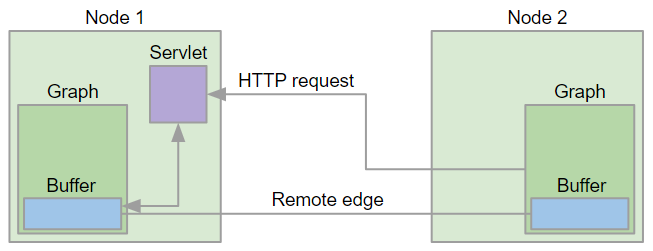
Remote Edges
Data transfer between graphs running on different nodes is performed by a special type of edge - remote edge. The edge utilizes buffers for sending data in fixed-sized chunks. Each chunk has a unique number; therefore, in the case of an I/O error, the last chunk sent can be re-requested.
You can set up values for various remote edge properties.
The following figure shows how nodes in Cluster communicate and transfer data - the client (graph running on Node 2) issues an HTTP request to Node 1 where a servlet accepts the request and checks the status of the source buffer. The source buffer is the buffer filled by the component writing to the left side of the remote edge. If the buffer is full, its content is transmitted to the Node 2, otherwise the servlet waits for configurable time interval for the buffer to become full. If the interval has elapsed without data being ready for download, the servlet finishes the request and Node 2 will re-issue the request at later time. Once the data chunk is downloaded, it is made available via the target buffer for the component reading from the right side of the remote edge. When the target buffer is emptied by the reading component, Node 2 issues new HTTP request to fetch the next data chunk.
This communication protocol and its implementation have consequences for the memory consumption of remote edges. A single remote edge will consume 3 x chunk size (1.5MB by default) of memory on the node that is the source side of the edge and 1 x chunk size (512KB by default) on the node that is the target of the edge. A smaller chunk size will save memory; however, more HTTP requests will be needed to transfer the data and the network latency will lower the throughput. Large data chunks will improve the edge throughput at the cost of higher memory consumption.

